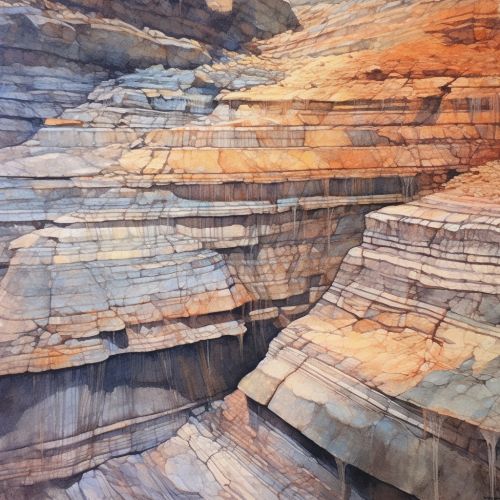Sedimentology
Introduction
Sedimentology is the scientific study of sediments and the processes by which they are formed. This discipline encompasses the analysis of the origin, occurrence, movement, accumulation, and lithification of sediments into sedimentary rocks. Sedimentologists apply their understanding of these processes to interpret sedimentary sequences, which can provide valuable information about Earth's history, including past climates, tectonic activities, and the evolution of life.


Sediment Types
Sediments are classified into three main types based on their origin: clastic, chemical, and organic.
Clastic Sediments
Clastic sediments are composed of fragments, or clasts, of pre-existing minerals and rocks. They are further classified based on grain size, from boulders and gravel to sand, silt, and clay. The study of these sediments involves understanding the processes of weathering and erosion that create the fragments, as well as the transportation and deposition processes that accumulate them in new locations.
Chemical Sediments
Chemical sediments are formed from the precipitation of minerals from water. This precipitation can occur through inorganic processes such as evaporation and chemical reactions, or through the biological activity of organisms. Examples of chemical sediments include evaporites, which form from the evaporation of saline water, and carbonates, which are often biologically precipitated.
Organic Sediments
Organic sediments, also known as biogenic sediments, are formed from the accumulation of plant and animal material. This includes coal, which is formed from terrestrial plant material, and chalk, which is formed from microscopic marine organisms.
Sedimentary Processes
Sedimentology encompasses the study of several key processes that contribute to the formation of sedimentary rocks. These include weathering, erosion, transportation, deposition, and lithification.
Weathering
Weathering is the process by which rocks are broken down into smaller fragments or altered chemically. It occurs in situ, meaning it takes place at the location of the rock. Weathering can be physical, such as when freeze-thaw action breaks rocks apart, or chemical, such as when rainwater reacts with minerals in the rock to form new minerals.
Erosion and Transportation
Erosion is the removal of weathered material from its source area. Agents of erosion include water, wind, ice, and gravity. Once eroded, the sediment is transported to a new location. The distance and method of transportation can significantly affect the characteristics of the sediment, including its grain size, shape, and composition.
Deposition
Deposition is the process by which sediments are laid down in a new location. This occurs when the energy of the transporting medium decreases below the threshold needed to carry the sediment. Depositional environments can range from terrestrial locations such as riverbanks and deserts, to marine settings such as continental shelves and deep-sea basins.
Lithification
Lithification is the process by which sediments are transformed into solid sedimentary rock. This involves compaction, where the weight of overlying sediments compresses the lower layers, and cementation, where minerals precipitate in the pore spaces between sediment grains and bind them together.
Applications of Sedimentology
Sedimentology has a wide range of applications in fields such as petroleum geology, hydrogeology, and environmental science.
Petroleum Geology
In petroleum geology, sedimentologists analyze sedimentary basins to identify potential locations for oil and gas reservoirs. They study the source rocks, reservoir rocks, and cap rocks in a basin, as well as the timing of sedimentation and tectonic events, to predict where hydrocarbons might be found.
Hydrogeology
In hydrogeology, sedimentologists study the properties of sediments and sedimentary rocks to understand how groundwater moves through the subsurface. This can help in managing water resources and remediating contaminated groundwater.
Environmental Science
In environmental science, sedimentologists study the transport and deposition of pollutants in the environment. They also analyze sediment records to understand past environmental conditions and predict future changes.
